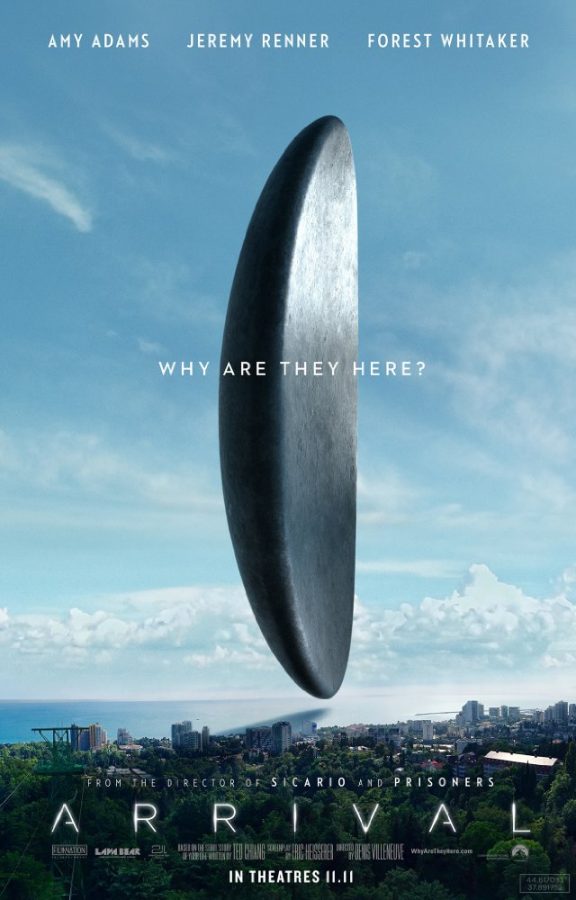“Arrival”: A Philosophical Take on Science-Fiction
November 20, 2016
Admittedly, I was thoroughly confused leaving the Manhasset theater after watching the movie Arrival. There was a sudden plot change involving a complete tangent from the story about aliens that made me think for a while after the movie. The fact that I couldn’t put the pieces together bothered me; I never thought so deeply after a film before.
Arrival begins with the emotional thoughts of Louise Banks (Amy Adams), a presumably single mother, college professor, and linguist. When multiple mysterious spacecrafts land on several parts around the world, people go into panic and fear the advance of extraterrestrials. In the United States, Louise Banks and Ian Donnelly (Jeremy Renner), a theoretical physicist, are recruited in order to communicate with and learn about the aliens, called Heptapods. Louise, as an expert linguist, learns the language of the Heptapods and begins to communicate with them; at the same time, she is haunted by her visions. Once Louise, as well as linguists at the other UFO locations, receive a seemingly threatening message from the Heptapods, the world falls into panic again, and countries start to arm themselves for war. On the other hand, Louise believes that there is an error in communication; it is up to her to appease the nations and save humanity.
Arrival, starring Amy Adams, Jeremy Renner, and Forest Whitaker, is based off the short story, Story of Your Life by Ted Chiang. Amy Adams and Jeremy Renner were previously co-stars in the widely-acclaimed film, American Hustle (2013). In addition, both actors starred in films dealing with alien invasions, Amy Adams in Man of Steel (2013) and Jeremy Renner in The Avengers (2012). Director Denis Villeneuve consulted with scientists Stephen and Christopher Wolfram in order to ensure that the science behind the film was accurate. With that said, there was an inaccuracy with the film’s promotional poster displayed a UFO above Hong Kong’s skyline, which included Shanghai’s Oriental Pearl Tower, causing a stir in Hong Kong social media outlets. Subsequently, the poster was deleted from all of Paramount’s social media accounts and was replaced by a corrected version in less than twenty-four hours. The other three locations of the UFOs in the film were the same locations of the alien tripods in the 1988 novel by John Christopher, When the Tripods Came. Arrival has received mostly positive reviews for its touching emotion and challenging ideas. It is different from the typical science-fiction film, as there does not seem to be a resolution; rather, it is up to the audience to determine the ending. The film gets people talking and thinking of its philosophical themes, distinguishing itself as the new movie experience.
Unlike many other recent films, Arrival may not be the best film for family entertainment, laughs or amusement. Rather, it will get viewers to think past typical boundaries to transcend the fourth dimension and time. As stated by the New York Times, Arrival does not have much action. Instead, it has vivid, realistic-looking computer-generated imagery (CGI) and visuals and complex concepts and ideas. Viewers will hold their breath in fear and awe as they realize the panic from the onset of the UFOs, see a different visualization of the “alien”, and take in the hopeless future of world collaboration. The Heptapods, seven-armed aliens that look dramatically different from the typical, green Martians, have a reason for being on Earth different than the usual malicious takeover sequence of nearly all science-fiction alien movies. There is a sense of eeriness that will keep watchers on the edge of their seats, expecting the unexpected, as well as an intermittent feeling of sorrow as Louise flashes into her forlorn visions. Besides its occasional quick cuts—which do go straight to the point—and its moment of random narration, Arrival succeeds in its presentation of content. In contrast to the main characters in many other movies, the protagonists of Arrival are two “mere” intellectuals, a linguist and a theoretical physicist, testing the idea that “normal people”—as opposed to superheroes, criminals, and celebrities—have the most interesting lives and abilities. In Arrival, the fate of the world laid upon these two academics, the heroes, making for an unprecedented perspective. Strengthened by the talent of Amy Adams, the character of Louise is the most important character in the film, the person who saves humanity from its destruction, the individual who wields the most extraordinary power. In addition, she is a woman whose actions determine the fate of the world. Louise breaks through the boundaries of the female character, depicted as incredibly intelligent—her mind not only equals that of a man’s but arguably surpasses it—and the foremost significant hero. The future was in her hands, and quite literally in her mind. Louise was the one to lead people in the right direction, even when they thought the problem was solved. Her mind worked unlike any other, demonstrating that a woman can have an impressive, powerful mind too.
Arrival may baffle the moviegoer, but it will astonish with its striking graphics and abstract, introspective concepts. It will expand the mind, scientifically and even socially, promising an exceptional movie experience.
